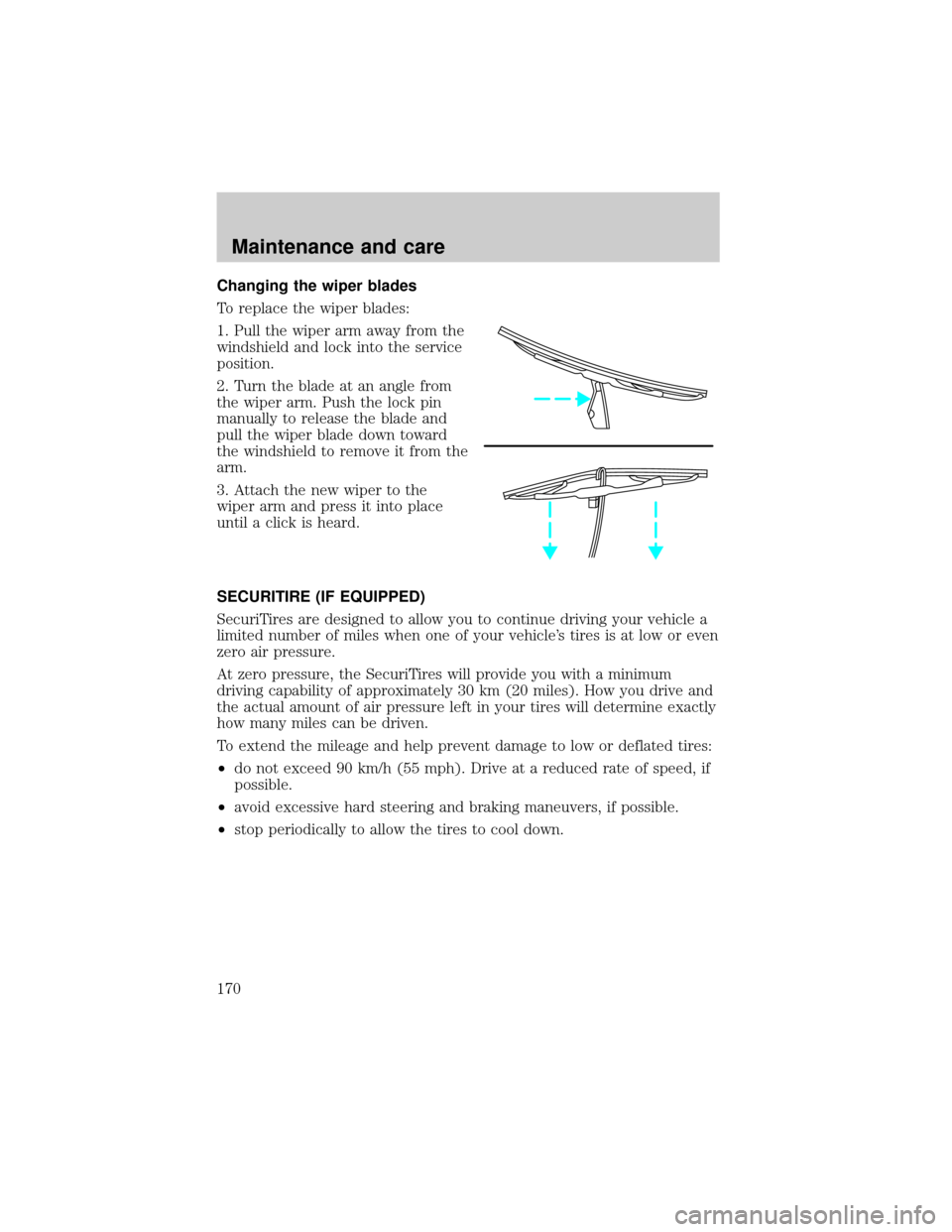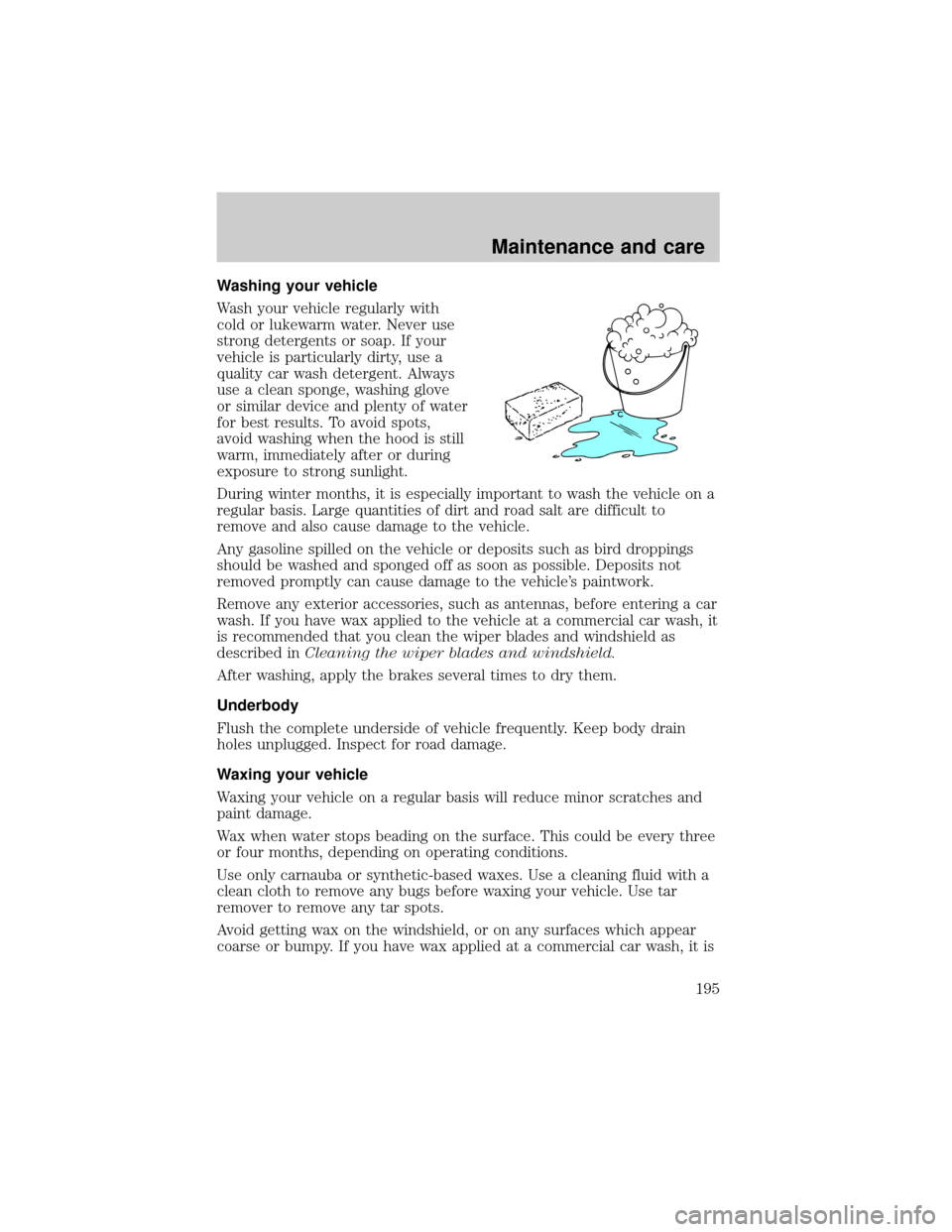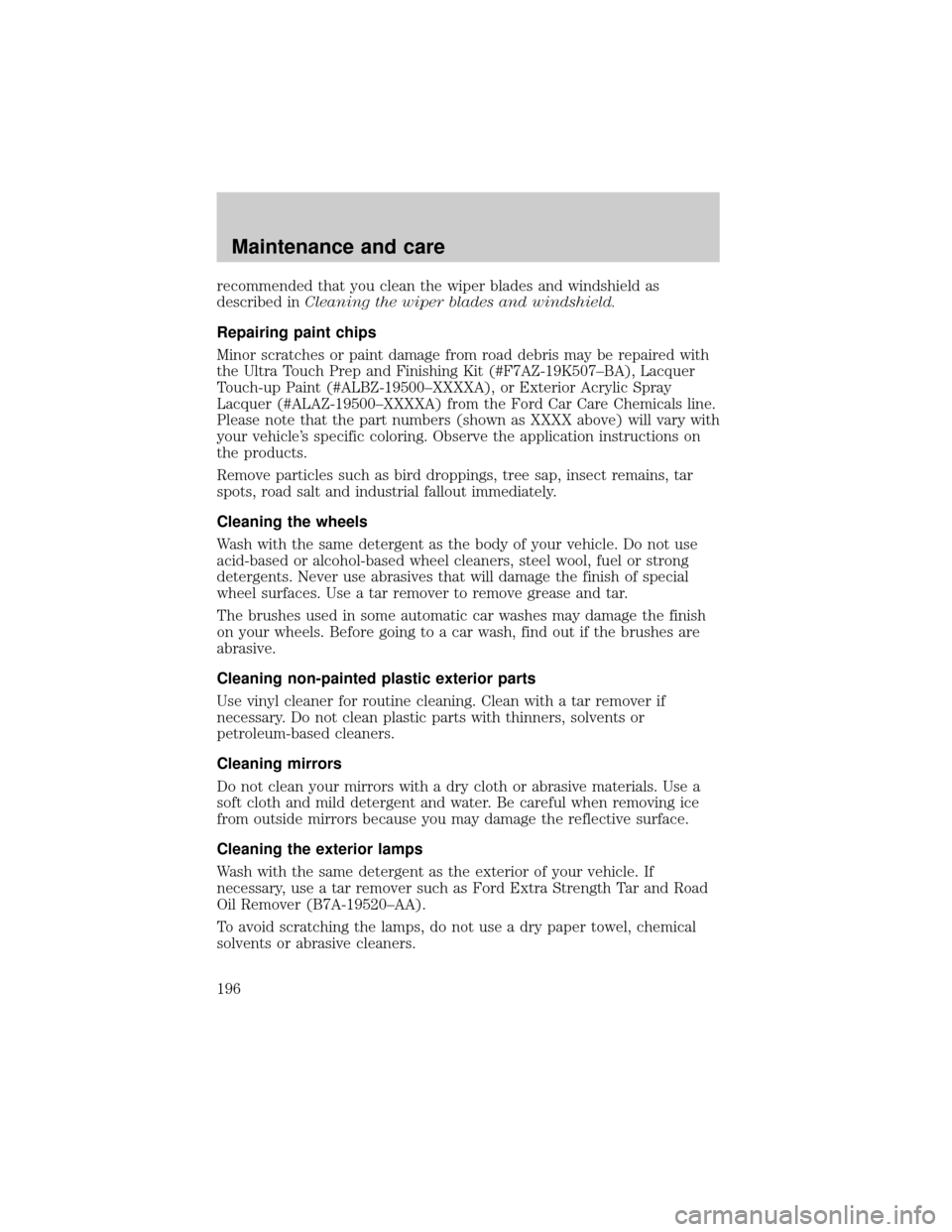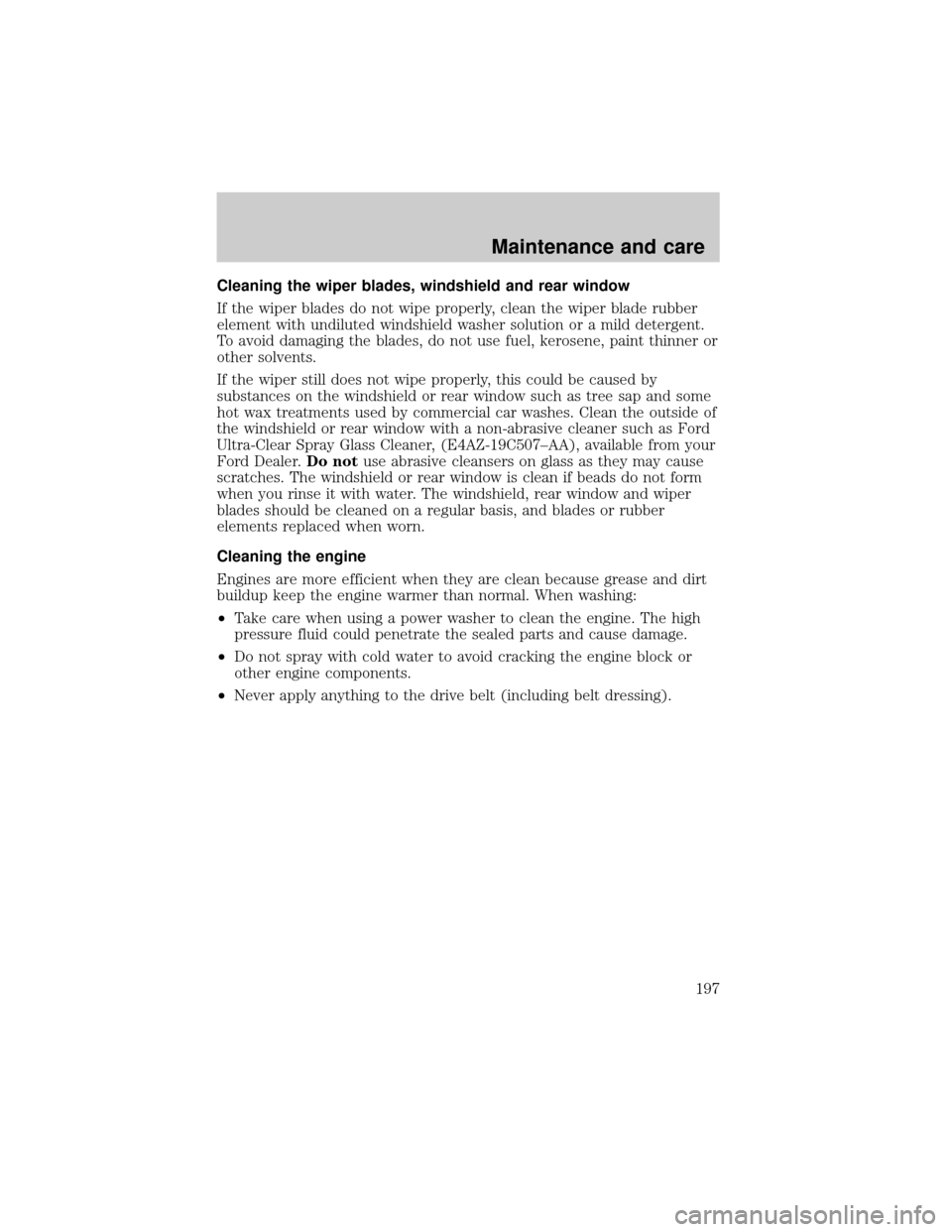2001 LINCOLN CONTINENTAL wiper blades
[x] Cancel search: wiper bladesPage 157 of 224

WINDSHIELD WASHER FLUID
Washer fluid
Check the washer fluid whenever
you stop for fuel. The reservoir is
highlighted with a
symbol.
If the level is low, add enough fluid
to fill the reservoir. In very cold
weather, do not fill the reservoir all
the way.
Only use a washer fluid that meets Ford specification. Refer to
Lubricant specificationsin theCapacities and specificationschapter.
State or local regulations on volatile organic compounds may restrict the
use of methanol, a common windshield washer antifreeze additive.
Washer fluids containing non-methanol antifreeze agents should be used
only if they provide cold weather protection without damaging the
vehicle's paint finish, wiper blades or washer system.
Do not put washer fluid in the engine coolant reservoir. Washer
fluid placed in the cooling system may harm engine and cooling
system components.
ENGINE COOLANT
Checking engine coolant
The concentration and level of engine coolant should be checked at the
mileage intervals listed in the scheduled maintenance guide. The coolant
concentration should be maintained at 50/50 coolant and water, which
equates to a freeze point of -36É C (-34É F). Coolant concentration
testing is possible with a hydrometer or antifreeze tester (such as the
Rotunda Battery and Antifreeze Tester, 014±R1060). The level of coolant
should be maintained at the ªcold fullº of ªcold fill rangeº level in the
coolant reservoir. If the level falls below, add coolant per the instructions
in theAdding Engine Coolantsection.
Your vehicle was factory-filled with a 50/50 engine coolant and water
concentration. If the concentration of coolant falls below 40% or above
60%, the engine parts could become damaged or not work properly.A
50±50 mixture of coolant and water provides the following:
Maintenance and care
157
Page 169 of 224

5. Remove the filter. Reverse the
procedure to install the new filter.
Be careful when installing the new filter. Avoid bending or tearing the
filter and make sure it is fully seated in its mounting location after
installation.
WINDSHIELD WIPER BLADES
Check the wiper blades at least twice a year or when they seem less
effective. Substances such as tree sap and some hot wax treatments used
by commercial car washes reduce the effectiveness of wiper blades.
Checking the wiper blades
If the wiper blades do not wipe properly, clean both the windshield and
wiper blades using undiluted windshield wiper solution or a mild
detergent. Rinse thoroughly with clean water. To avoid damaging the
blades, do not use fuel, kerosene, paint thinner or other solvents.
Maintenance and care
169
Page 170 of 224

Changing the wiper blades
To replace the wiper blades:
1. Pull the wiper arm away from the
windshield and lock into the service
position.
2. Turn the blade at an angle from
the wiper arm. Push the lock pin
manually to release the blade and
pull the wiper blade down toward
the windshield to remove it from the
arm.
3. Attach the new wiper to the
wiper arm and press it into place
until a click is heard.
SECURITIRE (IF EQUIPPED)
SecuriTires are designed to allow you to continue driving your vehicle a
limited number of miles when one of your vehicle's tires is at low or even
zero air pressure.
At zero pressure, the SecuriTires will provide you with a minimum
driving capability of approximately 30 km (20 miles). How you drive and
the actual amount of air pressure left in your tires will determine exactly
how many miles can be driven.
To extend the mileage and help prevent damage to low or deflated tires:
²do not exceed 90 km/h (55 mph). Drive at a reduced rate of speed, if
possible.
²avoid excessive hard steering and braking maneuvers, if possible.
²stop periodically to allow the tires to cool down.
Maintenance and care
170
Page 195 of 224

Washing your vehicle
Wash your vehicle regularly with
cold or lukewarm water. Never use
strong detergents or soap. If your
vehicle is particularly dirty, use a
quality car wash detergent. Always
use a clean sponge, washing glove
or similar device and plenty of water
for best results. To avoid spots,
avoid washing when the hood is still
warm, immediately after or during
exposure to strong sunlight.
During winter months, it is especially important to wash the vehicle on a
regular basis. Large quantities of dirt and road salt are difficult to
remove and also cause damage to the vehicle.
Any gasoline spilled on the vehicle or deposits such as bird droppings
should be washed and sponged off as soon as possible. Deposits not
removed promptly can cause damage to the vehicle's paintwork.
Remove any exterior accessories, such as antennas, before entering a car
wash. If you have wax applied to the vehicle at a commercial car wash, it
is recommended that you clean the wiper blades and windshield as
described inCleaning the wiper blades and windshield.
After washing, apply the brakes several times to dry them.
Underbody
Flush the complete underside of vehicle frequently. Keep body drain
holes unplugged. Inspect for road damage.
Waxing your vehicle
Waxing your vehicle on a regular basis will reduce minor scratches and
paint damage.
Wax when water stops beading on the surface. This could be every three
or four months, depending on operating conditions.
Use only carnauba or synthetic-based waxes. Use a cleaning fluid with a
clean cloth to remove any bugs before waxing your vehicle. Use tar
remover to remove any tar spots.
Avoid getting wax on the windshield, or on any surfaces which appear
coarse or bumpy. If you have wax applied at a commercial car wash, it is
Maintenance and care
195
Page 196 of 224

recommended that you clean the wiper blades and windshield as
described inCleaning the wiper blades and windshield.
Repairing paint chips
Minor scratches or paint damage from road debris may be repaired with
the Ultra Touch Prep and Finishing Kit (#F7AZ-19K507±BA), Lacquer
Touch-up Paint (#ALBZ-19500±XXXXA), or Exterior Acrylic Spray
Lacquer (#ALAZ-19500±XXXXA) from the Ford Car Care Chemicals line.
Please note that the part numbers (shown as XXXX above) will vary with
your vehicle's specific coloring. Observe the application instructions on
the products.
Remove particles such as bird droppings, tree sap, insect remains, tar
spots, road salt and industrial fallout immediately.
Cleaning the wheels
Wash with the same detergent as the body of your vehicle. Do not use
acid-based or alcohol-based wheel cleaners, steel wool, fuel or strong
detergents. Never use abrasives that will damage the finish of special
wheel surfaces. Use a tar remover to remove grease and tar.
The brushes used in some automatic car washes may damage the finish
on your wheels. Before going to a car wash, find out if the brushes are
abrasive.
Cleaning non-painted plastic exterior parts
Use vinyl cleaner for routine cleaning. Clean with a tar remover if
necessary. Do not clean plastic parts with thinners, solvents or
petroleum-based cleaners.
Cleaning mirrors
Do not clean your mirrors with a dry cloth or abrasive materials. Use a
soft cloth and mild detergent and water. Be careful when removing ice
from outside mirrors because you may damage the reflective surface.
Cleaning the exterior lamps
Wash with the same detergent as the exterior of your vehicle. If
necessary, use a tar remover such as Ford Extra Strength Tar and Road
Oil Remover (B7A-19520±AA).
To avoid scratching the lamps, do not use a dry paper towel, chemical
solvents or abrasive cleaners.
Maintenance and care
196
Page 197 of 224

Cleaning the wiper blades, windshield and rear window
If the wiper blades do not wipe properly, clean the wiper blade rubber
element with undiluted windshield washer solution or a mild detergent.
To avoid damaging the blades, do not use fuel, kerosene, paint thinner or
other solvents.
If the wiper still does not wipe properly, this could be caused by
substances on the windshield or rear window such as tree sap and some
hot wax treatments used by commercial car washes. Clean the outside of
the windshield or rear window with a non-abrasive cleaner such as Ford
Ultra-Clear Spray Glass Cleaner, (E4AZ-19C507±AA), available from your
Ford Dealer.Do notuse abrasive cleansers on glass as they may cause
scratches. The windshield or rear window is clean if beads do not form
when you rinse it with water. The windshield, rear window and wiper
blades should be cleaned on a regular basis, and blades or rubber
elements replaced when worn.
Cleaning the engine
Engines are more efficient when they are clean because grease and dirt
buildup keep the engine warmer than normal. When washing:
²Take care when using a power washer to clean the engine. The high
pressure fluid could penetrate the sealed parts and cause damage.
²Do not spray with cold water to avoid cracking the engine block or
other engine components.
²Never apply anything to the drive belt (including belt dressing).
Maintenance and care
197
Page 219 of 224

instrument panel ....................198
interior .....................................199
mirrors .....................................196
plastic parts ............................196
safety belts ..............................199
washing ....................................195
waxing .....................................195
wheels ......................................196
windows ..................................199
wiper blades ............................197
woodtone trim ........................198
Climate control (see Air
conditioning or Heating) ............27
Clock ............................................33
Compass, electronic ....................61
calibration .................................62
set zone adjustment .................61
Console ..................................68±69
Controls
power seat .................................84
steering column ........................51
Coolant
checking and adding ..............157
refill capacities ................161, 200
specifications ..................201±202
Cruise control
(see Speed control) ....................51
Customer Assistance ................132
Ford accessories
for your vehicle ......................212
Ford Extended
Service Plan ............................205
Getting assistance outside
the U.S. and Canada ..............211
Getting roadside assistance ...132
Getting the
service you need ....................205
Ordering additional
owner's literature ...................215The Dispute
Settlement Board ...................208
Utilizing the Mediation/
Arbitration Program ...............211
D
Daytime running lamps
(see Lamps) ................................25
Defrost
rear window ..............................33
Dipstick
automatic
transmission fluid ...................163
engine oil .................................153
Doors
lubricant specifications ..........201
Driving under special
conditions
through water .........................126
E
Electronic message center .........14
Emergencies, roadside
jump-starting ..........................144
Emission control system ..........184
Engine ........................................202
check engine/
service engine soon light ...........8
cleaning ...................................197
coolant .....................................157
idle speed control ...................165
lubrication
specifications ..................201±202
refill capacities ........................200
service points ..........................152
starting after a collision .........133
Engine block heater .................114
Index
219
Page 223 of 224

heated ........................................86
memory seat .............................75
SecuriLock passive
anti-theft system ...................79±81
Servicing your vehicle ..............150
Spark plugs, specifications ......200,
202
Specification chart,
lubricants ...........................201±202
Speed control ..............................51
Speedometer ...............................13
Starting your vehicle ........112, 114
jump starting ..........................144
Steering
speed sensitive .......................120
Steering wheel
controls ......................................51
tilting .........................................55
T
Tachometer .................................13
Tires ...........................140, 170±174
changing ..........................140±141
checking the pressure ............174
replacing ..................................175
rotating ....................................174
snow tires and chains ............175
tire grades ...............................173
treadwear ................................173
Towing .......................................128
recreational towing .................130
trailer towing ..........................128
wrecker ....................................149
Traction control ........................118
off light ......................................11Transaxle
automatic operation ...............121
fluid, refill capacities ..............200
lubricant specifications ..........202
Transmission
fluid, checking and adding
(automatic) .............................163
lubricant specifications ..........201
Trunk ...........................................82
remote release ....................67, 73
Turn signal ............................10, 49
V
Vehicle dimensions ...................202
Vehicle Identification Number
(VIN) ..........................................204
Vehicle loading ..........................126
Ventilating your vehicle ...........115
W
Warning chimes .....................11±12
Warning lights (see Lights) .........8
Washer fluid ..............................157
Water, Driving through .............126
Windows
power .........................................65
Windshield washer fluid and
wipers
checking and adding fluid .....157
checking and cleaning ............169
operation ...................................50
replacing wiper blades ...........170
Wrecker towing .........................149
Index
223